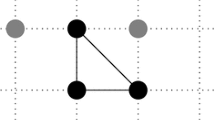Abstract
In the graph partitioning problem, as in other NP-hard problems, the problem of proving the existence of a cut of given size is easy and can be accomplished by exhibiting a solution with the correct value. On the other hand proving the non-existence of a cut better than a given value is very difficult. We consider the problem of maximizing a quadratic function x T Q x where Q is an n × n real symmetric matrix with x an n-dimensional vector constrained to be an element of {−1, 1} n. We had proposed a technique for obtaining upper bounds on solutions to the problem using a continuous approach in [4]. In this paper, we extend this method by using techniques of differential geometry.
Similar content being viewed by others
References
Gantmakher, F. (1959), Theory of Matrices, Chelsea.
Garey M. and Johnson D. (1979), Computers and Intractability: A Guide to the Theory of NP-Completeness, W. H. Freeman, San Francisco.
Han, C., Pardalos, P. and Ye, Y. (1989), Computational Aspects of an Interior Point Algorithm for Quadratic Problems with Box Constraints, Proc. of Conf. on Large-Scale Numerical Optimization, Cornell Univ.
Kamath, A. and Karmarkar, N. (1991), A Continuous Approach to Compute Upper Bounds in Quadratic Maximization Problems with Integer Constraints, Proc. of Conf. on Recent Advances in Global Optimization, eds. Floudas and Pardalos, pp. 125–140.
Kamath A., Karmarkar N., Ramakrishnan K. and Resende M. (1990), Computational Experience with an Interior Point Algorithm on the Satisfiability Problem, Annals of Opns. Res.. 25, 43–58.
Karmarkar N. (1984), A New Polynomial Time Algorithm for Linear Programming, Combinatorica 4, 373–395.
Karmarkar N. (1990), Riemannian Geometry Underlying Interior-Point Methods for Linear Programming, Contemporary Mathematics 114, 51–75.
Karmarkar, N. (1991), An Interior-Point Approach to NP-Complete Problems, Math. Develop. arising from Linear Prog., Proc. of a Joint Summer Research Conf., Bowdoin College, 1988, American Math. Soc. — Contemporary Math. 114, 297–308.
Karmarkar N., Resende M. and Ramakrishnan K. (1991), An Interior Point Algorithm to Solve Computationally Difficult Set Covering Problems, Mathematical Programming, Special Issue on “Interior Point Methods: Theory and Practice”, eds. Roos and Vial. 52, 597–618.
Luenberger, D. (1973), Linear and Nonlinear Programming, Addison Wesley.
Monteiro R. and Adler I. (1989), Interior Path Following Primal-Dual Algorithms, Part II: Convex Quadratic Programming, Mathematical Programming 44, 43–66.
Pardalos P. and Vavasis S. (1991), Quadratic Programming with One Negative Eigenvalue Is NP-hard, Journal of Global Optimization, 1, 15–22.
Rellich, F. (1969), Perturbation Theory of Eigenvalue Problems, Gordon and Breach.
Wilkinson J. (1965), The Algebraic Eigenvalue Problem, Clarendon Press, Oxford.
Author information
Authors and Affiliations
Rights and permissions
About this article
Cite this article
Kamath, A., Karmarkar, N. A continuous method for computing bounds in integer quadratic optimization problems. J Glob Optim 2, 229–241 (1992). https://doi.org/10.1007/BF00171827
Received:
Accepted:
Issue Date:
DOI: https://doi.org/10.1007/BF00171827




